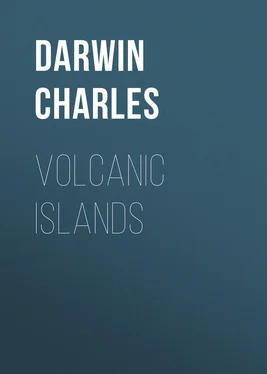Charles Darwin - Volcanic Islands
Здесь есть возможность читать онлайн «Charles Darwin - Volcanic Islands» — ознакомительный отрывок электронной книги совершенно бесплатно, а после прочтения отрывка купить полную версию. В некоторых случаях можно слушать аудио, скачать через торрент в формате fb2 и присутствует краткое содержание. Жанр: foreign_antique, foreign_prose, на английском языке. Описание произведения, (предисловие) а так же отзывы посетителей доступны на портале библиотеки ЛибКат.
- Название:Volcanic Islands
- Автор:
- Жанр:
- Год:неизвестен
- ISBN:нет данных
- Рейтинг книги:5 / 5. Голосов: 1
-
Избранное:Добавить в избранное
- Отзывы:
-
Ваша оценка:
- 100
- 1
- 2
- 3
- 4
- 5
Volcanic Islands: краткое содержание, описание и аннотация
Предлагаем к чтению аннотацию, описание, краткое содержание или предисловие (зависит от того, что написал сам автор книги «Volcanic Islands»). Если вы не нашли необходимую информацию о книге — напишите в комментариях, мы постараемся отыскать её.
Volcanic Islands — читать онлайн ознакомительный отрывок
Ниже представлен текст книги, разбитый по страницам. Система сохранения места последней прочитанной страницы, позволяет с удобством читать онлайн бесплатно книгу «Volcanic Islands», без необходимости каждый раз заново искать на чём Вы остановились. Поставьте закладку, и сможете в любой момент перейти на страницу, на которой закончили чтение.
Интервал:
Закладка:
As there is no escape for the rain-water, which trickles down the sides of the ravine-like hollow, whence the steam issues, it must all percolate downwards through the fissures at its bottom. Some of the inhabitants informed me that it was on record that flames (some luminous appearance?) had originally proceeded from these cracks, and that the flames had been succeeded by the steam; but I was not able to ascertain how long this was ago, or anything certain on the subject. When viewing the spot, I imagined that the injection of a large mass of rock. like the cone of phonolite at Fernando Noronha, in a semi-fluid state, by arching the surface might have caused a wedge-shaped hollow with cracks at the bottom, and that the rain- water percolating to the neighbourhood of the heated mass, would during many succeeding years be driven back in the form of steam.
TAHITI (OTAHEITE).
I visited only a part of the north-western side of this island, and this part is entirely composed of volcanic rocks. Near the coast there are several varieties of basalt, some abounding with large crystals of augite and tarnished olivine, others compact and earthy, – some slightly vesicular, and others occasionally amygdaloidal. These rocks are generally much decomposed, and to my surprise, I found in several sections that it was impossible to distinguish, even approximately, the line of separation between the decayed lava and the alternating beds of tuff. Since the specimens have become dry, it is rather more easy to distinguish the decomposed igneous rocks from the sedimentary tuffs. This gradation in character between rocks having such widely different origins, may I think be explained by the yielding under pressure of the softened sides of the vesicular cavities, which in many volcanic rocks occupy a large proportion of their bulk. As the vesicles generally increase in size and number in the upper parts of a stream of lava, so would the effects of their compression increase; the yielding, moreover, of each lower vesicle must tend to disturb all the softened matter above it. Hence we might expect to trace a perfect gradation from an unaltered crystalline rock to one in which all the particles (although originally forming part of the same solid mass) had undergone mechanical displacement; and such particles could hardly be distinguished from others of similar composition, which had been deposited as sediment. As lavas are sometimes laminated in their upper parts even horizontal lines, appearing like those of aqueous deposition, could not in all cases be relied on as a criterion of sedimentary origin. From these considerations it is not surprising that formerly many geologists believed in real transitions from aqueous deposits, through wacke, into igneous traps.
In the valley of Tia-auru, the commonest rocks are basalts with much olivine, and in some cases almost composed of large crystals of augite. I picked up some specimens, with much glassy feldspar, approaching in character to trachyte. There were also many large blocks of vesicular basalt, with the cavities beautifully lined with chabasie (?), and radiating bundles of mesotype. Some of these specimens presented a curious appearance, owing to a number of the vesicles being half filled up with a white, soft, earthy mesotypic mineral, which intumesced under the blowpipe in a remarkable manner. As the upper surfaces in all the half-filled cells are exactly parallel, it is evident that this substance has sunk to the bottom of each cell from its weight. Sometimes, however, it entirely fills the cells. Other cells are either quite filled, or lined, with small crystals, apparently of chabasie; these crystals, also, frequently line the upper half of the cells partly filled with the earthy mineral, as well as the upper surface of this substance itself, in which case the two minerals appear to blend into each other. I have never seen any other amygdaloid with the cells half filled in the manner here described; and it is difficult to imagine the causes which determined the earthy mineral to sink from its gravity to the bottom of the cells, and the crystalline mineral to adhere in a coating of equal thickness round the sides of the cells. (MacCulloch, however, has described and given a plate of ("Geolog. Trans." 1st series volume 4 page 225) a trap rock, with cavities filled up horizontally with quartz and chalcedony. The upper halves of these cavities are often filled by layers, which follow each irregularity of the surface, and by little depending stalactites of the same siliceous substances.)
The basic strata on the sides of the valley are gently inclined seaward, and I nowhere observed any sign of disturbance; the strata are separated from each other by thick, compact beds of conglomerate, in which the fragments are large, some being rounded, but most angular. From the character of these beds, from the compact and crystalline condition of most of the lavas, and from the nature of the infiltrated minerals, I was led to conjecture that they had originally flowed beneath the sea. This conclusion agrees with the fact that the Rev. W. Ellis found marine remains at a considerable height, which he believes were interstratified with volcanic matter; as is likewise described to be the case by Messrs. Tyerman and Bennett at Huaheine, an island in this same archipelago. Mr. Stutchbury also discovered near the summit of one of the loftiest mountains of Tahiti, at the height of several thousand feet, a stratum of semi-fossil coral. None of these remains have been specifically examined. On the coast, where masses of coral-rock would have afforded the clearest evidence, I looked in vain for any signs of recent elevation. For references to the above authorities, and for more detailed reasons for not believing that Tahiti has been recently elevated, I must refer to the "Structure and Distribution of Coral-Reefs."
MAURITIUS.
Approaching this island on the northern or north-western side, a curved chain of bold mountains, surmounted by rugged pinnacles, is seen to rise from a smooth border of cultivated land, which gently slopes down to the coast. At the first glance, one is tempted to believe that the sea lately reached the base of these mountains, and upon examination, this view, at least with respect to the inferior parts of the border, is found to be perfectly correct. Several authors have described masses of upraised coral- rock round the greater part of the circumference of the island. (Captain Carmichael, in Hooker's "Bot. Misc." volume 2 page 301. Captain Lloyd has lately, in the "Proceedings of the Geological Society" (volume 3 page 317), described carefully some of these masses. In the "Voyage a l'Isle de France, par un Officier du Roi," many interesting facts are given on this subject. Consult also "Voyage aux Quatre Isles d'Afrique, par M. Bory St. Vincent.") Between Tamarin Bay and the Great Black River I observed, in company with Captain Lloyd, two hillocks of coral-rock, formed in their lower part of hard calcareous sandstone, and in their upper of great blocks, slightly aggregated, of Astraea and Madrepora, and of fragments of basalt; they were divided into beds dipping seaward, in one case at an angle of 8 degrees, and in the other at 18 degrees; they had a water-worn appearance, and they rose abruptly from a smooth surface, strewed with rolled debris of organic remains, to a height of about twenty feet. The Officier du Roi, in his most interesting tour in 1768 round the island, has described masses of upraised coral-rocks, still retaining that moat-like structure (see my "Coral Reefs") which is characteristic of the living reefs. On the coast northward of Port Louis, I found the lava concealed for a considerable space inland by a conglomerate of corals and shells, like those on the beach, but in parts consolidated by red ferruginous matter. M. Bory St. Vincent has described similar calcareous beds over nearly the whole of the plain of Pamplemousses. Near Port Louis, when turning over some large stones, which lay in the bed of a stream at the head of a protected creek, and at the height of some yards above the level of spring tides, I found several shells of serpula still adhering to their under sides.
Читать дальшеИнтервал:
Закладка:
Похожие книги на «Volcanic Islands»
Представляем Вашему вниманию похожие книги на «Volcanic Islands» списком для выбора. Мы отобрали схожую по названию и смыслу литературу в надежде предоставить читателям больше вариантов отыскать новые, интересные, ещё непрочитанные произведения.
Обсуждение, отзывы о книге «Volcanic Islands» и просто собственные мнения читателей. Оставьте ваши комментарии, напишите, что Вы думаете о произведении, его смысле или главных героях. Укажите что конкретно понравилось, а что нет, и почему Вы так считаете.












